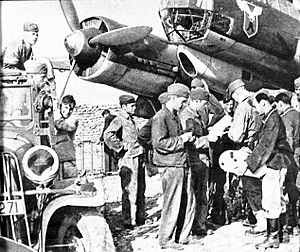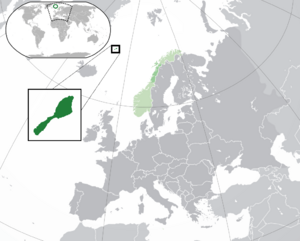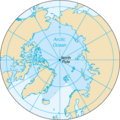Convoy PQ 14 facts for kids
Quick facts for kids Convoy PQ 14 |
|||||||
|---|---|---|---|---|---|---|---|
| Part of Arctic naval operations of the Second World War | |||||||
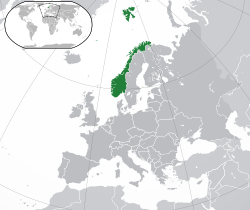 German occupied Norway (in green) along the flank of the sea route to northern Russia |
|||||||
|
|||||||
| Belligerents | |||||||
| Allies | Germany | ||||||
| Commanders and leaders | |||||||
| Stuart Bonham Carter | Hans-Jürgen Stumpff | ||||||
| Units involved | |||||||
| PQ 14 and escorts | Luftflotte 5 | ||||||
| Strength | |||||||
| 26 merchant ships varying number of escorts |
|||||||
| Casualties and losses | |||||||
| 1 ship sunk 16 ships turned back with ice damage |
1 Junkers Ju 88 | ||||||
Convoy PQ 14 was a group of ships traveling together for safety. This particular convoy was sent from Britain by the Allies to help the Soviet Union during World War II. These convoys had been sailing since August 1941, often using the dark Arctic winter to hide.
However, in early 1942, Germany sent more aircraft and ships to Norway. This made the journey much more dangerous. Convoy PQ 14 sailed in April 1942, when the days were getting longer. On April 10-11, thick fog and ice damaged 16 ships, forcing them to turn back to Iceland. On April 16, German planes and submarines attacked, sinking one merchant ship. The remaining seven ships finally reached Murmansk, a port in Russia. This meant the Allies would need to send even larger convoys later to deliver all the needed supplies.
Contents
What Were Arctic Convoys?
Helping Allies in World War II
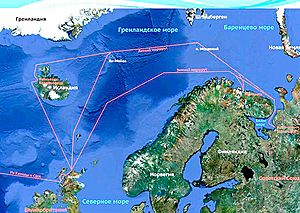
After Germany invaded the USSR in June 1941, Britain and the Soviet Union agreed to help each other. The United States also joined in. This help was part of a program called "Lend-Lease." It meant the Allies would send important supplies to the Soviet Union.
The Soviet Union needed a lot of military equipment. Their factories were being moved, so they couldn't make enough planes and tanks. Britain and the US promised to send hundreds of aircraft and tanks every month. They also sent raw materials, food, and medical supplies.
Why the Arctic Route Was Important
The route to the Soviet Union's northern ports, like Murmansk, was very difficult. It involved sailing through the Arctic Ocean. This area has some of the stormiest waters in the world. The sea is freezing cold, and spray can quickly turn to ice on ships. This ice had to be removed constantly to stop ships from becoming too heavy and tipping over.
In winter, the polar ice spreads south, forcing ships closer to German air bases in Norway. In summer, the ice melts, allowing ships to sail further out. But in summer, there's almost constant daylight, which makes it easy for enemy planes to spot convoys. The mixing of cold and warm water in the Arctic also creates thick fog, which could hide convoys but also make navigation tricky.
German Forces in Norway
Germany wanted to stop these convoys. They sent more planes and ships to Norway. The German air force, called the Luftwaffe, especially its unit called Luftflotte 5, was ordered to attack the convoys. They also worked with the German navy, the Kriegsmarine.
The Luftwaffe used long-range planes like the Focke-Wulf Fw 200 Kondor to find convoys. Once a convoy was spotted, they would try to attack it continuously. They also had Junkers Ju 88 bombers.
The Journey of Convoy PQ 14
Getting Ready
Convoy PQ 14 was made up of 26 merchant ships from Britain, the US, the Soviet Union, the Netherlands, and Panama. They gathered in Scotland and then sailed to Iceland on March 26, 1942. From Iceland, they would begin their dangerous journey to Russia.
The convoy had many escort ships to protect it. These included destroyers, minesweepers, and anti-submarine trawlers. Larger warships, like the cruisers HMS Edinburgh and Norfolk, and even battleships like HMS Duke of York and King George V, were part of the distant escort. An aircraft carrier, HMS Victorious, also provided protection.
Trouble with Ice and Fog
Convoy PQ 14 left Iceland on April 8, 1942. On the night of April 10-11, the convoy ran into thick fog that lasted for 30 hours. Then, they sailed through dangerous pack ice for 12 hours. The ships were thrown into chaos, and many were badly damaged by the ice.
Because of the damage, 16 ships and two minesweepers had to turn back. They couldn't continue the journey. Only eight merchant ships and their escorts were able to press on towards Murmansk.
German Attacks Begin
For a few days, the convoy had no trouble from German forces. But on April 15, east of Bear Island, German reconnaissance planes spotted the convoy. Small air attacks began.
On April 16, the attacks became more serious. The merchant ship Empire Howard was hit by three torpedoes from a German submarine, U-403. The ship sank in less than a minute. Many crew members were killed by the shockwaves from the depth charges dropped by the escorting trawler Northern Wave, which was trying to attack the U-boat. Another trawler, Lord Middleton, rescued 18 men, but nine of them, including the convoy leader, later died.
Reaching Murmansk
On April 17, Soviet destroyers joined the convoy to help with the escort. German bombers, Junkers Ju 88, arrived, but the ships' gunners shot one down. The bombers failed to hit any ships. Later, a British destroyer, Bulldog, attacked a German U-boat.
On April 18, the weather cleared, and more British minesweepers joined the convoy. A strong gale blew up on the final leg of the journey. Finally, on April 19, the seven remaining ships entered Kola Inlet and docked at Murmansk. Even there, they were attacked by German bombers while being unloaded.
What Happened Next?
Even though seven ships made it, many had to turn back because of ice damage. This meant fewer supplies reached the Soviet Union than planned. The Allies knew they would have to send even bigger convoys during the summer. This was a concern because the longer daylight hours in the Arctic summer made convoys easier to spot and attack. The British Navy predicted that future convoys would face "serious losses."
Ships of Convoy PQ 14
Merchant Ships
| Name | Flag | GRT | Notes |
|---|---|---|---|
| RFA Aldersdale (1937) | 8,402 | ||
| Andre Marti (1918) | 2,352 | Turned back to Iceland, then to UK | |
| Arcos (1918) | 2,343 | Damaged by ice, turned back to Iceland | |
| Atheltemplar (1930) | 8,992 | Arrived Murmansk 19 April | |
| Botavon (1912) | 5,848 | Damaged by ice, turned back to Iceland | |
| Briarwood (1930) | 4,019 | Arrived Murmansk 19 April | |
| British Corporal (1922) | 6,972 | Damaged by ice, turned back to Iceland | |
| City of Joliet (1920) | 6,167 | Damaged by ice, turned back to Iceland | |
| Dan-Y-Bryn (1940) | 5,117 | Arrived Murmansk 19 April | |
| Empire Bard (1942) | 3,114 | Heavy lift ship damaged by ice, turned back to Iceland | |
| Empire Howard (1941) | 6,985 | Sunk by U-403 16 April | |
| Exterminator (1924) | 6,115 | Detached 12 April to Convoy QP 10 | |
| Francis Scott Key (1941) | 7,191 | Damaged by ice, turned back to Iceland | |
| Hegira (1919) | 7,588 | Damaged by ice, turned back to Iceland | |
| Hopemount (1929) | 7,434 | Arrived Murmansk 19 April | |
| Ironclad (1919) | 5,685 | Detached to Convoy QP 10 | |
| Minotaur (1918) | 4,554 | Damaged by ice, turned back to Iceland | |
| Mormacrio (1919) | 5,940 | Damaged by ice, turned back to Iceland | |
| Pieter De Hoogh (1941) | 7,168 | Damaged by ice, turned back to Iceland | |
| Seattle Spirit (1919) | 5,627 | Damaged by ice, turned back to Iceland | |
| Sukhona (1918) | 3,124 | Damaged by ice, turned back to Iceland | |
| Trehata (1928) | 4,817 | Arrived Murmansk 19 April | |
| West Cheswald (1919) | 5,711 | Arrived Murmansk 19 April | |
| West Gotomska (1918) | 5,728 | Damaged by ice, detached to Convoy QP 10 | |
| Yaka (1920) | 5,432 | Arrived Murmansk 19 April, later bombed and beached |
Escort Ships
| Name | Flag | Type | Notes |
|---|---|---|---|
| HMS Amazon | Destroyer | 12–19 April | |
| Beagle | Destroyer | 12–19 April | |
| Bedouin | Destroyer | 12–18 April | |
| Belvoir | Escort destroyer | 12–13 April | |
| HMS Beverley | Destroyer | 12–19 April | |
| Bulldog | Destroyer | 12–19 April | |
| Campanula | Corvette | 12–19 April | |
| Chiltern | ASW trawler | 8–12 April | |
| HMS Duke of York | Battleship | 12–18 April | |
| Duncton | ASW trawler | 12–13 April | |
| Escapade | Destroyer | 12–18 April | |
| Eskimo | Destroyer | 12–18 April | |
| Faulknor | Destroyer | 12–18 April | |
| Foresight | Destroyer | 12–19 April | |
| Forester | Destroyer | 12–19 April | |
| Gossamer | Minesweeper | 18–19 April | |
| Harrier | Minesweeper | 18–19 April | |
| Hebe | Minesweeper | 8–13 April | |
| Hussar | Minesweeper | 18–19 April | |
| Kent | Heavy cruiser | 12–20 April | |
| HMS King George V | Battleship | 12–18 April | |
| Ledbury | Escort destroyer | 12–18 April | |
| Lord Austin | ASW trawler | 8–19 April | |
| Lord Middleton | ASW trawler | 8–19 April; rescued 18 crew from Empire Howard on 16 April; nine survivors | |
| Matchless | Destroyer | Escort 12–18 April | |
| Middleton | Escort destroyer | 12–18 April | |
| Niger | Minesweeper | 18–19 April | |
| Nigeria | Light cruiser | 12–18 April | |
| Norfolk | Heavy cruiser | 10–17 April | |
| Northern Wave | ASW trawler | 8–19 April | |
| Offa | Destroyer | 12–18 April | |
| Onslow | Destroyer | 12–18 April | |
| Oxlip | Corvette | 12–19 April | |
| Saxifrage | Corvette | 12–19 April | |
| Snowflake | Corvette | 8–19 April | |
| Somali | Destroyer | 12–18 April | |
| Speedy | Minesweeper | Escort 8–13 April, turned back to Iceland, damaged by ice | |
| Victorious | Aircraft carrier | 12–18 April | |
| Wheatland | Escort destroyer | 12–13 April | |
| Wilton | Escort destroyer | 8–12 April |
German Destroyer Group
| Name | Flag | Ship Type | Notes |
|---|---|---|---|
| Z7 Hermann Schoemann | Destroyer | 11–18 April | |
| Z24 | Destroyer | 11–18 April | |
| Z25 | Destroyer | 11–18 April |
Images for kids


